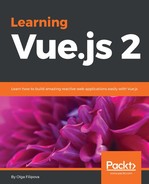In this chapter, you saw how to use the events handling and triggering mechanism to propagate the components' data changes to their parents.
Most importantly, you used the power of Vuex architecture to be able to establish the data flow between the components. You saw how the store is created, and its main parts, mutations, and states. You learned how to structure the application that uses the store so that it becomes modular and maintainable. You also learned how to create the store's getters and how to define actions that dispatch the store state's mutations. We applied all the learned mechanisms to our applications and saw the data flow in action.
At this point, we are able to use any data exchanging mechanism in Vue applications, starting from simple local data binding inside the components and going further to global state management. At this point, we know all the bases to operate data inside our Vue application. We're almost done!
In the next chapter, we will go deep into the plugins system for Vue applications. You will learn how to use existing plugins and create your own plugin to enrich your applications with custom behavior.
